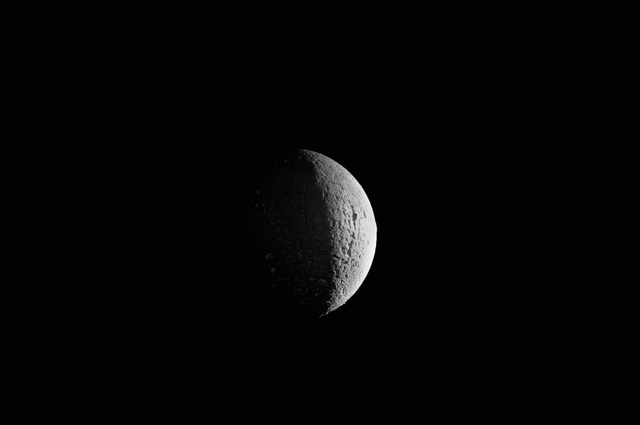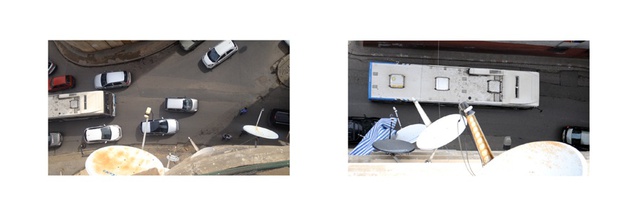Reviews
Intervening Space
From the Intimate to the World
The exhibition Intervening Space: From the Intimate to the World, an exhibition curated by Yasmina Reggad of Aria (Artist Residency in Algiers) at The Mosaic Rooms, showed pieces by six artists of Algerian descent working either in the country or within the diaspora today. Ranging in media, from sound installation to video, etchings, found objects, and installation, each piece expressed spatial meaning in various forms. These included the personal, such as Hanan Benammar's sound piece Prenons un air dégagé: We already had no history (2014) based on objects of familial value, to the communal, such as Massinissa Selmani's consideration of the development of the overcrowded inner city neighbourhood of Diar Echems entitled Diar Echems (Maisons du soleil) (2013–2014).
In the case of Fayçal Baghriche's Half of What You See (2010), viewers stepped inside a darkened room to find themselves standing somewhere outside the solar system, almost as if viewing it from a separate planet. A shadow, a light, and an eclipse moved around the room while the moon spun at the centre of it, going from being completely lit to darkness, with nothing but a slightly rough and bumpy surface visible. Standing between the darkness and the circular rotations of light was inviting, comforting and actually awe inspiring: within this universe, everything felt peaceful.
In his statement on the work, Baghriche notes that he is questioning what we know and what we believe, merging solid reality with imagination. Baghriche takes us out of hard reality and shows us what we can't see. In this darkened room, the experience of standing in the darkness produced a macro view of a universe. At the same time, positioned between the light and its projections, the work revealed how each spectator was in fact bigger than all of these elements: the light, the planets and their motion.
Thinking about such interstitial spaces in this exhibition, other pieces expressed the layers of history making up Algeria's urban landscapes, communicating intriguing relationships and interstices. Atef Berredjem's two-channel video installation Continuum (2014) allowed us to stare down on a street through two screens – one of the videos shot on high resolution, the other by camera phone. The only thing that differs is the width of the framing, at some points the register of light, and finally, the shakiness captured on the camera phone – the humanity that emerges from behind these static images. Past the satellites hung on the building's exterior, there are cars passing by on this everyday street, one just like any other in the Middle East where people have erupted in protest in the last few years. The calm quietness we perceive in this small street, however, offers a view into the time/space relationship between the current demonstrations occurring in streets across the greater region, the relative calmness of this street now, and the Algerian revolution of 50 years ago. Cars continue to pass by, but all we hear is the wind brushing past the camera, the odd car horn and, at some points, the faint sound of music from a radio. It is interesting to note, however, that this work was a change from the originally intended piece documenting narratives of travellers on the train between Algiers and Annaba. According to the description, the piece was meant to highlight the liminal nature of mobility and would have been more engaging than the static films exhibited.
Amina Menia's Enclose #0 (2013) was a grand visual layout of the history of a monument located in the heart of Algiers, which formed an additional layer to her ongoing research (since 2009) on funerary public sculptures in Algeria. This particular monument holds a double narrative – the sculpture was created by Polish-French sculptor Paul Landowski in 1928 and was commissioned by the French authorities to commemorate French and Algerian martyrs. 50 years later, the mayor of Algiers commissioned well-known modernist artist, M'hamed Issiakhem, to 'do something' about the monument's loud colonial presence. Issiakhem decided to cover it with a concrete structure with reliefs on the lower part and a fist of empowerment protruding from the back. This added another tier to the monument, extending the history that it recounts. It was ultimately renamed Monument to the Martyrs. Menia's tracing of this fascinating story brings forward a very palpable and contentious historical relationship through the frame of this one monument. Simultaneously, she highlights the harmonious way that this modern artist responded to history with an empowering act, even if it was tinted with the nostalgia of heroism. Menia's look into these different monuments in Algeria's landscape is an exciting mapping of a history through demagogic appeals, both pre- and post-colonial, and their mark on the public space and thus collective consciousness. The title of this piece, Enclosed #0, may indicate that there is more to come from this particular story.
As an exhibition with a national focus, the curatorial note promised a binary feel of inside to outside with a turn towards the point where spaces meet. The inclusion of historical narratives and abstract realms gave the exhibition its intimate distance, one where the viewer could relate to the multiple stories referencing Algeria from the vantage point of remoteness. Altogether, ideas are suspended more than claims, stressing that 'nation', 'nationality' and 'heritage' are subjective. The personal distances relayed in the works of Intervening Space gave this nation-focus an inviting element by the way it transcended the boundaries of Algeria as a geographical locale, looking at different modes of diaspora and displacement and the inclusion of an ongoing colonial narrative in the minds of people inside and outside of the places these pieces speak of. The artists' situational and temporal frictions are ones that many people who have experienced these same elements of colonial history, migration and exile, in Algeria and in so many other countries and regions worldwide, can relate to.
Intervening Space: From the Intimate to the World, was on show at The Mosaic Rooms from 15 May to 28 June 2014.

















